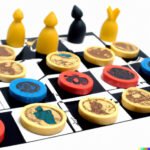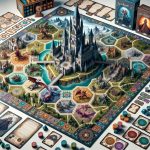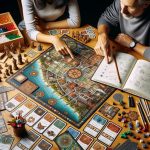Are you ready to unleash your creativity and strategic thinking? In this article, we will explore the exciting world of strategy war board games and how you can create your very own. The appeal of crafting a game tailored to your unique vision and gameplay experience is one that many find irresistible. From developing the concept to designing the artwork, making your own strategy war board game is a rewarding endeavor that allows for endless creativity and innovation.
Creating a strategy war board game opens up a world of possibilities where you have complete control over the rules, gameplay mechanics, and overall design. Whether it’s immersing players in an epic battle or challenging them with intricate tactical decisions, the process of bringing your game to life is both fulfilling and thrilling.
Throughout this article, we will delve into the steps involved in crafting your game, from conducting research and planning to playtesting and refinement. We’ll also discuss the importance of game components, mechanics, design elements, and manufacturing options.
Whether you are an experienced designer or a newcomer to the world of board games, there’s something here for everyone who dreams of creating their own immersive gaming experience. So let’s get started on this exciting journey into the realm of strategy war board games.
Research and Planning
Creating your own strategy war board game involves careful research and planning to ensure that your game is both engaging and unique. Before diving into the creative process, it’s important to thoroughly research existing games in the genre. By analyzing what makes successful strategy war board games tick, you can identify elements that resonate with players and incorporate them into your own game.
To develop a solid concept for your game, consider the theme, setting, and overall gameplay experience you want to create. Will your game be set in medieval times or a futuristic dystopia? Will it involve resource management, combat, or diplomacy?
Thinking about these aspects will help you shape the core mechanics of the game and create a unique identity for your creation. Keep in mind that a successful strategy war board game provides players with meaningful strategic decisions while immersing them in a compelling narrative.
When it comes to creating a strategic and immersive gameplay experience, consider how different components of the game interact with each other. How do different units, buildings, or territories affect each other within the game world? Balancing these interactions is crucial for creating depth and replay value in your strategy war board game.
Tips for Creating a Strategic and Immersive Gameplay Experience
One way to achieve this is by incorporating asymmetric gameplay where players have access to unique abilities or advantages based on their chosen faction or scenario. Furthermore, providing players with multiple paths to victory can create tension and excitement as they navigate through different strategic opportunities.
In addition to conducting thorough research on existing games, taking inspiration from historical events, mythology, or futuristic scenarios can help you develop an engaging theme for your strategy war board game. By immersing players in a richly detailed world with compelling characters and stories, you can elevate the overall gaming experience and make your creation stand out.
By carefully planning and researching these key aspects of game development, you can lay a solid foundation for creating an impactful strategy war board game.
Game Components
Creating an engaging and immersive strategy war board game begins with carefully considering the game components. These essential elements are crucial in providing players with a strategic and enjoyable gaming experience. From game pieces to the board itself, every component plays a significant role in creating a captivating game that will keep players coming back for more.
Detailed List of Essential Game Components
Before diving into creating your own strategy war board game, it is important to outline the essential components needed. These may include playing pieces, cards, dice, the game board, tokens, and any other elements necessary for gameplay. Each component serves a specific purpose in the overall gaming experience and should be carefully designed and considered.
Tips for Sourcing or Creating Game Pieces and Boards
When it comes to sourcing or creating game pieces and boards, there are various options to consider. You can choose to create custom pieces and boards using materials like wood, plastic, or cardboard. Alternatively, you can also find pre-made materials from suppliers specializing in tabletop games. Whichever route you choose to take, it is important to ensure that the quality of the components matches the vision you have for your game.
Considerations for Creating a Visually Appealing Game
In addition to functionality, visual appeal also plays a crucial role in capturing the attention of players. Consider factors such as color schemes, theme-appropriate designs, and high-quality print materials when creating your game components. The visual presentation of your strategy war board game can greatly impact its success and appeal to potential players.
By paying careful attention to each aspect of your strategy war board game’s components during the creation process, you will lay a strong foundation for an engaging and visually stunning gaming experience. Whether it’s sourcing materials or designing unique game pieces, this stage sets the stage for an exciting journey in board game creation – one that ensures your vision becomes a reality.
Game Mechanics
Once you have developed the concept for your strategy war board game and gathered the necessary components, it’s time to focus on creating the game mechanics. The game mechanics are essentially the rules and systems that dictate how the game is played and how players interact with the game world. Here are some steps to guide you in creating the game mechanics for your own strategy war board game:
1. Establish Game Rules:
Whether it’s movement, combat, resource management, or victory conditions, it’s crucial to clearly define the rules of your game. This includes outlining player actions, turn structure, and any special abilities or powers within the game.
2. Balance Strategy and Chance:
A successful strategy war board game strikes a balance between strategic decision-making and elements of chance. Consider how luck or randomness will factor into gameplay through dice rolls, card draws, or other mechanisms. It’s important to ensure that chance doesn’t overshadow strategic thinking while still adding an element of surprise to the game.
3. Playtesting and Refinement:
Once you have established initial game mechanics, it’s essential to playtest your game extensively with a variety of players. Gather feedback on what works well and what needs improvement. This might involve tweaking rules, adjusting abilities, or reworking victory conditions based on player experiences.
By carefully crafting compelling game mechanics, you can enhance the overall gameplay experience of your strategy war board game and make it more engaging for players.
Design and Artwork
Creating visually appealing and captivating artwork for your strategy war board game is an essential aspect of the game design process. The design and artwork of your game can greatly enhance the overall gaming experience, drawing players into the world you’ve created and immersing them in the gameplay. When considering how to make your own strategy war board game, it’s important to pay attention to the visual storytelling elements of your game.
One key resource for designing a captivating game board and packaging is to utilize graphic design software such as Adobe Illustrator or Photoshop. These tools offer a wide range of options for creating custom graphics, illustrations, and designs that can bring your game board to life. Additionally, there are many online tutorials and resources available that can provide guidance on using these software programs effectively.
In addition to the game board, creating compelling artwork for your game pieces, cards, and other components is crucial. Visual appeal plays a significant role in attracting players to your game, so investing time and effort into creating high-quality artwork will greatly benefit the overall success of your strategy war board game.
| Design and Artwork Tips | Resources |
|---|---|
| Utilize graphic design software like Adobe Illustrator or Photoshop | Online tutorials for graphic design software |
| Create compelling artwork for game pieces, cards, and components | Artistic inspiration from existing games |
Playtesting and Refinement
After you have completed the initial design and development of your strategy war board game, the next crucial step is playtesting and refinement. This phase is essential for ensuring that your game mechanics are engaging, balanced, and intuitive for players. Here are some important steps to consider on how to make your own strategy war board game successful through playtesting and refinement:
- Recruit a diverse group of playtesters: Gather a mix of experienced gamers and individuals who may be new to strategy war games. This will provide valuable feedback from different perspectives and skill levels.
- Collect thorough feedback: Create surveys or questionnaires to gather detailed feedback from playtesters. Ask specific questions about their overall experience, what they enjoyed, what they found confusing, and any suggestions for improvement.
- Iterate and refine: Use the feedback gathered during playtesting to make refinements to your game mechanics. This might involve adjusting rules, balancing player abilities, or tweaking the overall gameplay experience.
It’s important during this phase to remain open-minded and willing to make changes based on the feedback you receive. Playtesting is an invaluable opportunity to identify potential flaws or areas for improvement in your game before it goes into production.
Another key aspect of refining your strategy war board game involves balancing and adjusting the gameplay based on the feedback you receive. Striking the right balance between strategy and chance is essential in creating an enjoyable gaming experience. Throughout the playtesting process, pay close attention to how players interact with your game mechanics and look for ways to maintain a strategic element while introducing elements of unpredictability.
In addition, analyzing playtesting feedback can help you understand patterns or common issues that arise during gameplay. By identifying recurring challenges or points of confusion, you can focus on making targeted improvements that will enhance the overall experience for future players of your strategy war board game.
Manufacturing and Distribution
Once you have completed the playtesting and refinement phase of creating your own strategy war board game, the next step is to consider how you want to manufacture and distribute your game. There are several options available for bringing your game to life and getting it into the hands of eager players.
One option is self-publishing, where you take on the responsibility of overseeing the manufacturing process, as well as marketing and distributing the game yourself. This can be a good choice for independent creators who want to maintain creative control over their game. Another option is seeking out a publisher who specializes in board games. Working with a publisher can provide additional resources and expertise when it comes to manufacturing, marketing, and distribution.
When it comes to actually manufacturing your game, there are various companies that specialize in producing board games. You’ll need to do some research to find a manufacturer that aligns with your vision for the game and fits within your budget. From there, you’ll work with the manufacturer to bring your game components, boards, and packaging to life.
Finally, once your game has been manufactured, it’s time to think about distribution. Whether you’ve chosen self-publishing or working with a publisher, you’ll need a plan for getting your game into stores or directly into the hands of players through online sales. Marketing plays a crucial role in this phase as well – spreading the word about your game through social media, gaming conventions, and other channels will help drum up interest among potential players.
| Manufacturing Options | Distribution Strategies |
|---|---|
| Self-publishing | Retail store distribution |
| Publisher collaboration | Online sales |
| Third-party manufacturers | Marketing through social media and gaming conventions |
Conclusion
In conclusion, creating your own strategy war board game can be a rewarding and fulfilling endeavor. From researching and planning to designing artwork and playtesting, the process offers numerous opportunities for creativity and innovation. By following the steps outlined in this guide, you can develop a game that not only provides a strategic and immersive gameplay experience but also showcases your unique vision and storytelling ability.
As you embark on your journey to create a strategy war board game, remember that it’s important to stay open to feedback and be willing to revise and refine your game mechanics. Playtesting with a diverse group of individuals can provide valuable insights into how to improve the overall gameplay experience. Whether you choose to pursue self-publishing or seek out a publisher, there are various avenues available for manufacturing and distributing your game.
In closing, the resources and inspiration provided in this guide should serve as a solid foundation for those looking to make their own strategy war board game. The world of tabletop gaming continues to evolve, offering endless opportunities for designers to contribute their own unique creations. So if you have a creative vision and passion for gaming, don’t hesitate to dive in and make your dream game a reality.
Frequently Asked Questions
How Do You Create a Game Strategy?
Creating a game strategy involves analyzing the game’s rules and mechanics, understanding your opponents’ potential moves, and planning your own moves accordingly. It also involves adapting your strategy as the game progresses.
How Do I Design My Own Board Game?
Designing your own board game requires creativity, patience, and attention to detail. Start with a clear concept and rules, then create a prototype to test gameplay. Refine the design based on feedback and playtesting.
How to Make a Model of a Board Game?
Making a model of a board game begins with conceptualizing the game’s layout, components, and rules. Use materials like cardboard, paper, or 3D modeling software to create a physical or digital representation of the game board and pieces.

I love playing all kinds of games – from classics like Monopoly to modern favourites like Ticket to Ride.
I created this blog as a way to share my love of board games with others, and provide information on the latest releases and news in the industry.





